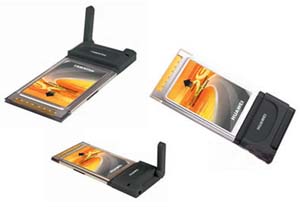Data Card WAR
A tale of two data cards
BY ZAM KARIM ‘THE STAR TECH Correspondence’

E600
(Huawei Technologies Co Ltd)
3G data card
Network band: GSM900/1800 (2G), GPRS (2.5G), WCDMA (3G)
System requirements: Windows 98SE and above, Pentium 100 or above, 32MB RAM, PC Card slot Type II, CD-ROM drive
Other features: antenna, microphone and earphone port for voice service (earpiece included)
Price: RM1,549 and monthly access fee depending of 3G plan
Website:www.huawei.com
Review unit courtesy of Celcom (Malaysia) Bhd, (03) 3630-8888

MERLIN-U530
(Lucent Technologies and Novatel Wireless Inc)
3G data card
Connectivity: GSM900/1800 (2G), GPRS (2.5G), WCDMA (3G)
System requirements: Windows 2000 and above, 16MB of hard disk space, 64MB RAM, PC Card slot
Type II, CD-ROM drive
Price: RM1,599 and monthly access fee RM149
Website:www.novatelwireless.com
Review unit courtesy of Maxis Communications Bhd, (03) 7492-2123
FRET not when you're on the go and your WiFi-enabled laptop is out of any WiFi coverage area. Thanks to 3G mobile technology, you can now still surf the Internet wirelessly.
Although users could surf the Net on a mobile telecommunications network before the advent of 3G, it was via a GPRS (General Packet Radio Service) connection that is limited to about 40Kbps (kilobits per second).
When Celcom and Maxis announced the availability of commercial 3G networks that offer surfing speeds of up to 384Kbps (seven times that of GPRS), yours truly immediately jumped at the opportunity to test out their services with two separate data cards.
The data cards can be used with almost any laptop with a PC Card slot to provide high-speed Internet and e-mail access.
Celcom uses the E600 data card from Huawei Technologies while Maxis employs the Merlin-U530 data card from Lucent Technologies and Novatel Wireless Inc.
Both cards offer seamless connection to GPRS and WCDMA 2.0 (3G) networks, so if you're in an area with no 3G coverage, the cards will switch to the well-established GPRS networks automatically. You can keep track of things by referring to the data card software’s network signal indicator (3G or 2.5G). But the best indicator for me is when your swift download speed suddenly reduces to a crawl.
Simple installation
Both solutions are easy to install. All you have to do is to install the bundled software – Huawei E600 (Celcom) and MobiLink (Maxis). Once completed, just slide in the data card (with the 3G SIM card) into the laptop's PC Card slot. The card will then be initiated upon a PC reboot. Once the software is loaded, you will be greeted with a dashboard-like control panel. If everything goes as planned, you will be able to surf right away.
It is that easy – there is no need to tinker with any settings as the software has all the bases covered.
Through the dashboard, you can immediately access the Internet or your e-mail. Both data cards also allow you to send and receive SMS messages while you're surfing the Web.
However, the Celcom data card offers extra features that the Maxis data card doesn't.
These include an external antenna to boost reception, as well as a microphone/headphone port for connecting a handsfree kit. This means the Celcom data card allows you to surf the Web, send and receive SMS messages and make a voice call at the same time. To be fair, Maxis will launch their 3G integrated voice service tomorrow, so we might soon see a Maxis data card with similar features.
The cost of convenience
Both service providers claim that their 3G services allow up to 384Kbps for downloads and up to 64Kbps for uploads. I tested the cards in several locations around Klang Valley where the signal strength varied considerably. In Shah Alam, where there was only a two-bar reception, I managed to get a mediocre connection of around 160Kbps.
In the more upmarket areas such as Damansara, where the reception was stronger, the speed increased to about 285Kbps.
On average, I managed to get speeds of around 200Kbps to 350Kbps when there was strong reception.
While this is still slower than a streamyx connection (512Kbps), the 3G connection is still plenty fast for the kinds of applications mobile workers are likely to use, and it's certainly a massive improvement over GPRS. You can even stay connected to the network for however long you want because you only pay for the amount of data you send and receive.
To subscribe to the Celcom 3G network, users have to purchase the data card for RM1,549. On top of that they will have to decide which 3G package (pay-per-use, 3MB and unlimited plans) that they want to subscribe to.
Those interested in Maxis 3G must also buy the data card, which costs RM1,599 (inclusive of the 3G SIM card). Unlike Celcom, however, Maxis has a flat rate of RM150 per month for unlimited surfing.
Conclusion
The main draw of using a 3G network connection is its speedy Internet connection via a mobile telecommunications network.
However, thanks to its high cost, only mid- to high-end users would find this an acceptable business expense.
E600 Pros: Headache-free installation, speedy broadband connection; can make voice calls E600 Cons: Pricey Merlin Pros: Easy installation; fast broadband connection Merlin Cons: Pricey; cannot make voice calls.
